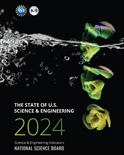
Dramatic changes in science & engineering landscape call for new U.S. strategies
National Science Board releases new policy brief

U.S. Research and Development by source of funds: 1953 - 2022 (Credit and Larger Version)
July 22, 2024
It is time for new approaches that embrace a dramatically changed science and technology landscape to secure U.S. leadership and deliver the benefits of scientific and technological progress to all Americans. That’s according to a new policy brief the National Science Board released today.
"I’m dedicating my term as Chair of the National Science Board to considering how we as a nation can adapt to and seize the potential of the current landscape, says Darío Gil, who is also Senior Vice President and Director of Research at IBM. “Starting this week, when we’re bringing together government, academic, and philanthropic leaders for a panel discussion, the Board will be convening cross-sectoral leaders to explore and advance ideas for new and necessary models."
Gil says that NSB’s new policy brief is intended as a conversation starter and an open invitation.
The brief lays out three fundamental changes in the S&T landscape:
1) Federal investment is the foundation, but business funds the majority of U.S. R&D
- Since 1980, business has funded the largest share of U.S. Research and Development (R&D) and over the last decade, has dramatically accelerated in growth.
- Business has shifted from being primarily a beneficiary of investment to being a driver in its own right.
- Business R&D drove U.S. R&D to 3.5% of GDP in 2021. However, while this should be celebrated, R&D is not a substitute for federal R&D. Only the federal government can invest across all fields, across the nation, at scale, and over sufficiently long-time horizons. Business and federal R&D are complementary.
2) The People’s Republic of China (PRC) is our biggest competitor and collaborator
- U.S. leadership in S&T is being challenged by China’s rising investment in S&T.
- China has now surpassed the U.S. in research publications, patents (including in AI), in knowledge-and technology-intensive manufacturing, and in awarding PhDs in STEM.
- China is a formidable competitor in technology areas critical for national security, such as AI, semiconductors, quantum computing, and biotechnology.
- China is also the U.S.’ largest collaborator in published research, including in AI.
3) The number of jobs requiring STEM skills continues to rapidly rise
- The U.S. is failing to adequately educate and nurture its domestic students and workers.
- Among advanced economies, U.S. K-12 students have long been merely “middle of the pack” in STEM performance – and the pandemic erased the gains that U.S. students made in mathematics proficiency in the past 20 years.
- The U.S. is a beacon for STEM talent from around the globe. The share of U.S. S&E doctorate-level workers who are foreign-born has grown from 27% in 1993 to 43% in 2021.
- Foreign talent is a key strength but also a risk. Our dependency is at an all-time high – especially in critical and emerging technology areas – but the U.S. is not offering adequate ways to retain talent that wants to stay and work in the U.S.
These fundamental changes have happened against a backdrop where a robust S&T enterprise is now essential to national economic and national security.
Says Gil: “One consequence of the success of U.S. science and technology over the last 75 years is that S&T now has the same kind of economic and geopolitical importance as trade or military alliances. It is at the heart of national economic and defense competitiveness.”
In his first address as NSB Chair this week, Gil will give a presentation on the changed science and technology landscape, followed by National Science Foundation (NSF) Director Panchanathan, who will give examples of how NSF is responding to these changes. Leaders in government, philanthropy, and academia will then join the Board for a panel discussion on the changes they’ve seen in their respective sectors and identify areas that will require new cross-sector collaborations. Gil will moderate the discussion and offer an industry perspective.
About the National Science Board
The National Science Foundation Act of 1950 charged the NSB with two roles: governing board of the NSF and advisor to Congress and the President on policy matters related to STEM research and STEM education. Selected for their distinguished service and accomplishments in academia, government, and the private sector, the Board’s 24 presidentially appointed members are leaders in STEM research and STEM education.
Media Contact Nadine Lymn, National Science Board, (703) 292-2490, nlymn@nsf.gov
Useful NSB Web Sites:
Home Page: http://www.nsf.gov/nsb
Media Contact: http://www.nsf.gov/staff/staff_bio.jsp?lan=nlymn&org=NSF
News: http://www.nsf.gov/nsb/news
Meetings: http://www.nsf.gov/nsb/meetings
Publications: http://www.nsf.gov/nsb/publications
Facebook: https://www.facebook.com/NationalScienceBoard
Twitter: Twitter: https://twitter.com/intent/user?screen_name=NSF_NSB
YouTube: https://www.youtube.com/channel/UCkrHRzuGSrPp2haQs0T_Pww
To view PDF documents, please download Adobe Acrobat Reader.




